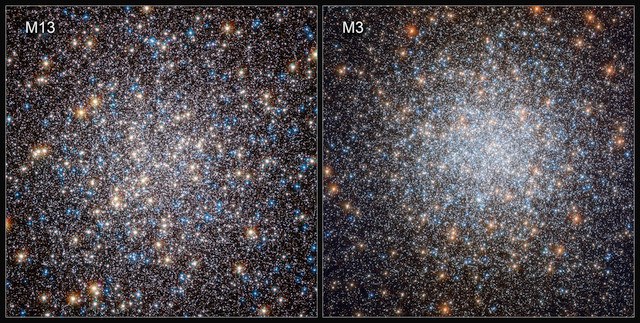Some stars age at a different rate
Some White Dwarf stars retain a thin layer of hydrogen that allows them to produce energy for a longer period of time and thus extend the final stage of their life. The discovery was made by a research team led by scientists from the University of Bologna and the National Institute for Astrophysics (INAF)
HST images of the twin globular clusters M13 (left) and M3 (right) (Credit: ESA/Hubble & NASA, G. Piotto et al.)
Some stars age differently: it happens when - in the final stage of their life - they store a small energy reserve that makes them look younger than they actually are. The discovery was made by a research group led by scientists from the University of Bologna and the National Institute for Astrophysics (INAF) by comparing the populations of White Dwarfs in two twin star systems using the Hubble Space Telescope.
"White Dwarf" refers to the final stage that concerns the vast majority of stars in the Universe (approximately 98%), including the Sun. During this stage, the star loses its outer layers until only the “naked” core is preserved. After that, the star cannot produce energy anymore and gradually cools and loses its luminosity until it slowly dims.
Until now, all White Dwarfs have been thought to age in the same way and at the same rate. The study was published in Nature Astronomy and shows for the first time how some white Dwarf Stars age more slowly than others. In these longer-lived stars, a thin layer of hydrogen is preserved allowing for thermonuclear reactions that produce energy.
A NEW DEFINITION OF "WHITE DWARF"
"Through our observations, we found that White Dwarfs age differently. This is quite surprising as it is the opposite of what was previously thought," says the first author of the study Jianxing Chen, PhD student at the University of Bologna and INAF member.
"Our discovery changes the very definition of White Dwarf as we usually teach it to students enrolled in astrophysics courses. Moreover, this discovery opens up a new perspective on the processes that control the aging of stellar structures", adds the study coordinator Francesco Ferraro, INAF member, and professor at the Department of Physics and Astronomy “Augusto Righi” of the University of Bologna.
Moreover, these results have an impact on the way astrophysicists measure the age of the stars in the Milky Way. Until now, the relationship between age and luminosity or temperature of white dwarf stars was thought to be so close that the aging rate of these stars had been used as a natural clock.
“The collected data show that this clock should be used with caution,” explains Emanuele Dalessandro, INAF researcher and co-author of the study. "Now we know that some White Dwarfs age at a slower rate. Therefore, the error in determining the age can be significant and can go up to a billion years."
The team at the Bologna University (UniBO) and Italian National Institute for Astrophysics (INAF). From left to right, Francesco Ferraro (UniBO-INAF), Barbara Lanzoni (UniBO-INAF), Jianxing Chen (UniBO-INAF), Cristina Pallanca (UniBO-INAF), Mario Cadelano (INAF), Emanuele Dalessandro (INAF).
STAR CLUSTERS COMPARED
The discovery was made possible by deep observations taken with the Hubble Space Telescope. In particular, the scientists studied the images from two globular star clusters known as Messier 3 and Messier 13 (M3 and M13). Since these two systems are comparable in terms of age and metal content, they are an ideal pair for a comparative study of stellar populations.
The comparison was surprising. In the same magnitude range, M13 counted a significantly larger population of White Dwarfs (460) than that of M3 (326). The difference is even more striking if we take into account that there are fewer stars in M13 than in M3. According to the researchers, the explanation lies in the characteristics of the White Dwarfs in M13, especially in their slower aging process. As they dim at a slower rate, in a specific magnitude range the number of stars still observable is greater in M13 than in M3.
A THIN LAYER OF HYDROGEN
Why are "long-lived" White Dwarfs in M13 and not in M3? The key to the mystery lies in their past. When a star approaches the final stage of its life, the hydrogen in its outer layer is transported into the innermost regions through a mixing process. There, the hydrogen is burnt. Thus, there is no residual hydrogen in stars when they reach the White Dwarf state.
However, the activation process cannot begin in stars with a lower mass. As most of the stars in M3 have a higher mass than those in M13, they undergo the "mixing" process and cannot produce energy during the final stage of their life, thus they age more rapidly.
"Our discovery shows that some White Dwarfs retain a thin layer of hydrogen - in the order of one-ten-thousandth of the Sun's mass - which allows a minimal thermonuclear activity", Francesco Ferraro affirms. "Energy production slows down the process of dimming and cooling, consequently slowing down the aging rate too".
THE AUTHORS OF THE STUDY
The study was published in Nature Astronomy under the title "Slowly cooling white dwarfs in M13 from stable hydrogen burning". Both scholars from the University of Bologna - Department of Physics and Astronomy "Augusto Righi" - and INAF members took part in the study, namely Jianxing Chen, Francesco R. Ferraro, Barbara Lanzoni and Cristina Pallanca, with Mario Cadelano and Emanuele Dalessandro. Maurizio Salaris from Liverpool John Moores University, UK, and Leandro Althaus from Universidad Nacional de La Plata, Argentina, also took part in the study.


